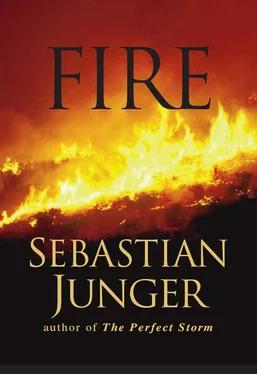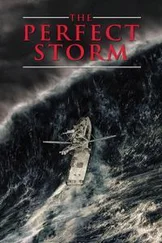A siege mentality developed in Glenwood Springs. Questions of specific culpability were construed as lack of respect for the fire fighters and even for the dead. On Monday, July 11, the Glenwood Post ran an article titled “Glenwood Incident Commander: Plans for Escape Worked,” a daring stance to adopt concerning a fire in which fourteen people died. Butch Blanco had told the Grand Junction Daily Sentinel the day before that one smoke jumper (Hipke) who’d escaped had started his run behind the ill-fated Prineville crew. That suggested to him that there had been sufficient time to reach a safe area ahead of the fire. “Whether they [the Prineville nine] didn’t take it seriously, I don’t know,” he said.
The first people to see the dead were the smoke jumpers who had deployed fire shelters below H-1. “I walked straight to the lower group of bodies and called for a helicopter,” said smoke jumper Anthony Petrilli. “They asked if we needed medevac. I told him it was too late for that, and then I walked up the hill and found six more.”
An hour later twenty-six smoke jumpers helicoptered in to investigate further. It was an early, unnatural dusk on the mountain as they picked their way past the charred bodies. They reported eleven dead and three missing. Within an hour, Governor Romer was on the scene; he told the smoke jumpers he wanted to remove the bodies as quickly as possible. The jumpers objected, saying that this was no different from a crime scene and the bodies should be left until someone examined them. Romer abided by their wishes. The next morning investigators began to measure things, ponder the dynamics of the mountain, and coax secrets from the dead.
The first question was how fast the fire had moved, and Haugh’s estimate—that the last three hundred feet were covered in about twelve seconds—turned out to be close. In the end, the investigators confirmed that the fire had covered the quarter-mile slope in about two minutes, hitting its top speed of 18 mph in the dried-out Gambel oak.
The next question was why it had done that. Fire behavior is determined by an incredibly complicated interaction of fuel, terrain, and wind, and there are mathematical models describing the interaction. (The models are programmed into hand-held calculators carried by most incident commanders these days.) The deadly hillside faced west at a 33 to 50 percent slope, and the vegetation on it possessed burning characteristics described in a formula called Fuel Model Number Four. The moisture content of the small dead fuels on Storm King Mountain was around 3 percent. And the live Gambel oak (which had only been partly burned earlier) was several times drier than normal. In a light wind, according to this model, those conditions would produce twenty-three-foot flames spreading at a maximum of seven hundred feet an hour.
That’s a manageable fire, or at least one that can be outrun, but an increase in wind speed can change the situation dramatically. At 7:20 P.M. on Tuesday (less than twenty-four hours before the blowup), the National Weather Service issued a “Red Flag” fire warning for the area around Glenwood Springs. Dry thunderstorms were expected the following morning, followed by southwest winds gusting up to 30 mph. A cold front would come through sometime that afternoon, swinging the winds to the northwest.
Gusts of 35 mph, plugged into Fuel Model Number Four, produce sixty-four-foot flames racing up the mountain at up to fifteen feet per second. In the superdry Gambel oak, the rate of spread would have been almost twice that—much faster than any human can run. The lessons of the Battlement Mesa fire (detailed in the Situation #8 video) had not been learned: A small fire on steep ground covered with extremely dry vegetation had once more exploded in a mathematically predictable way—again, with tragic results.
The 226-page federal investigators’ report concluded that just about everyone involved had been negligent in some way. Ground crews had been arrogant about the fire danger; supervisors had ignored local fuel and drought conditions; and the Western Slope Fire Coordination Center had failed to relay crucial weather information to the fire crews in the field. “Extreme fire behavior could have been predicted by using weather forecasts and information readily obtainable at the BLM Grand Junction District Office,” read one of many such findings.
The most horrifying conclusion of the report was that twelve of the victims could have easily escaped from the valley if they had started running when evidence of extreme danger first emerged. Instead, they began a slow walk, some of them dying with their tools in their hands. This meant two things: The order for an all-out retreat was given far too late, and the victims had an inherent reluctance to acknowledge the seriousness of their situation. “Putting down the saw jacked the pucker factor up one notch,” said smoke jumper Petrilli, who himself had not accepted the fact that he was running for his life until he put down his tools. The last thing fire fighters are supposed to do is give up a saw or shovel, so they are understandably loath to do so, since it means they are in a life-threatening situation.
“I know in my heart,” said Haugh, “that the twelve persons who died in that part of the fire were unaware of what was happening.” By the time the Prineville nine and the three smoke jumpers with them saw the horror coming—by the time great sheets of flame hit the dry Gambel oak and frantic voices over the radio screamed at them to run—they had only twenty seconds to live. They must have died in a state of bewilderment almost as great as their fear.
The last living harpooner wakes to the sound of wind. It has been blowing for two weeks now, whipping up a big ugly sea, ruining any chance of putting out in the boat. On this strong, steady wind, the northeast trades, European slave ships rode to the New World bringing fifteen million Africans across the Atlantic. One of their descendants now creeps through his house in the predawn gloom, wishing the wind would stop.
The man’s name is Athneal Ollivierre. He is six feet tall, seventy-four years old, straight and strong as a dock piling. His hair rises in an ash gray column, and a thin wedge of mustache suggests a French officer in the First World War. On his left leg, there’s the scar of a rope burn that went right down to the bone. His eyes, bloodshot from age and the glare of the sun, focus on a point just above my shoulder and about five hundred miles distant. In the corner of his living room rests a twenty-pound throwing iron with a cinnamonwood shaft.
Ollivierre makes his way outside to watch the coming of the day. The shutters are banging. It’s the dry season; one rainfall and the hills will be so covered with poui flowers that it will look as if it had just snowed. Shirts hang out to dry on the bushes in front of his house, and a pair of humpback jawbones forms a gateway beyond which sprawls the rest of his world, seven square miles of volcanic island that drop steeply into a turquoise sea. This is Bequia, one of thirty-two islands that make up the southern Caribbean nation of St. Vincent and the Grenadines. Friendship Bay curves off to the east, and a new airport, bulldozed across the reefs, juts off to the west. More and more tourists and cruise ships have been coming to Bequia, the planes buzzing low, the gleaming boats anchoring almost nightly in the bay, but at the moment that matters very little to Ollivierre. He’s barefoot in the tropical grass, squinting across the water at a small disturbance in the channel. Through binoculars it turns out to be a wooden skiff running hard across the channel for the island of Mustique. It emerges, disappears, emerges again behind a huge green swell.
Читать дальше












